With the launch of the third book in his “Following . . .” series, Dr Peter Roennfeldt talked about what he has learnt in writing these books and the growing disciple-making movement in the South Pacific.
What do you understand as “the apostles’ vision”?
That there be no place left where Christ is not known. Before His crucifixion, Jesus had systematically sown the seeds of His movement across the region—Judea, Samaria, Galilee, Decapolis, Gaulantis, Phoenicia and Perea. He commissioned His followers to multiply disciples in all “nations”—and the word used (ethne) indicates they were to take the gospel into every relational stream or “tribe, language and people” (see Matthew 28:18–20; Revelation 14:6). It was a bold vision.
What is not well understood about Paul’s missionary work?
Perhaps it is that he so faithfully followed the model and methods of Jesus in making disciples and cultivating His movement. Paul’s life was radically and completely redefined by Jesus’ death and resurrection, and His Spirit’s anointing and presence.
And Paul gave new disciples full responsibility for mission in their regions. A local church was not left to simply care for itself—but to take responsibility for disciple-making, baptising and multiplying God’s kingdom movement across the region. In today’s language, one small church in a home in the western suburbs of Sydney would be enough to then multiply across the region—using Jesus’ methods.

What caught you by surprise in re-reading Paul’s letters in this way?
How refreshing Paul’s idea of church would be for today. It was a tough environment, and we must not entertain romantic notions of them being faultless. But the letters indicate the churches of that time were small, relational, on-the-paths of life, incarnational—in their communities—and multiplying.
I had no idea that the letters were such a rich resource to understand, not only what the apostles had taught, but how they had worked under such difficult circumstances. Our forms and systems of church reflect post-fourth century frames. I had not realised the value of the New Testament epistles for redefining what church could be.
Looking back over the three “Following . . .” books, what do you think this series adds up to?
I hope it is an opportunity to reflect—for disciple-makers and movement leaders to look beyond traditional assumptions, to see a revival and continuation of the movement of Jesus and the book of Acts in our world today.
Why has the format changed across the three books?
Following Jesus was purposely written as a reading guide. It was first used with neighbours and friends who knew little of Jesus—and is still used in this way. However, I have seen the transformation experienced by believers and Christian leaders when they spend a year following Jesus’ life in sequence.
Following the Spirit walks through Acts, exploring how the early believers applied what they had learned from Jesus’ life and equipping in disciple-making and movement-building. It is exciting—but confronting and challenging. And yes, this book Following the Apostles’ Vision is different. It is a how-to book—with many insights into how the principles of the epistles are being applied—but it is not prescriptive.
As you have travelled and taught on these themes across the South Pacific, what are you noticing?
The main reaction across Australia, New Zealand and the Pacific counties has been, “We can do this! We can share faith using Jesus’ model—and plant faith communities as reflected in the New Testament.” In some places churches are restructuring, members are forming teams according to where they live, Discovery Bible Reading groups are multiplying, and new churches are springing up in and under homes.
These books have been a catalyst to journey with Jesus and early believers. We are reminded that “Christ’s method alone will give true success in reaching the people.” His method is simple, anyone-can-do-it and reproducible, at no cost. I think these books have contributed to encouraging engagement as disciples at grassroots level.
Following the Apostles’ Vision and other books by Peter Roennfeldt is available from Adventist bookshops in Australia, New Zealand and the South Pacific, or online.






